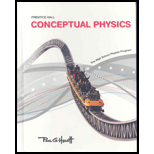
What is the mathematical relationship between how long it takes a planet to orbit the sun and its distance from the sun?

The mathematical relationship between time taken by a planet to orbit the Sun and its distance from the sun.
Answer to Problem 13A
The mathematical relationship between how long it takes a planet to orbit the sun and its distance from the sun is
Explanation of Solution
Given:
Planets orbit around the sun.
Formula used:
The expression for the gravitational force between the planet and the sun as follows:
Here,
The expression for the centripetal force as follows:
Here,
Calculation:
Consider the gravitational force between the planet and Sun provides the centripetal force acting on the planet. That is
The mathematical relationship between planet’s revolution period to orbit the sun and planet’s distance from the sun is,
Conclusion:
Thus, the mathematical relationship between how long it takes a planet to orbit the sun and its distance from the sun is
Chapter 14 Solutions
Conceptual Physics: The High School Physics Program
Additional Science Textbook Solutions
Life in the Universe (4th Edition)
Physics for Scientists and Engineers: A Strategic Approach, Vol. 1 (Chs 1-21) (4th Edition)
The Cosmic Perspective
Physics: Principles with Applications
Essential University Physics: Volume 1 (3rd Edition)
 College PhysicsPhysicsISBN:9781305952300Author:Raymond A. Serway, Chris VuillePublisher:Cengage Learning
College PhysicsPhysicsISBN:9781305952300Author:Raymond A. Serway, Chris VuillePublisher:Cengage Learning University Physics (14th Edition)PhysicsISBN:9780133969290Author:Hugh D. Young, Roger A. FreedmanPublisher:PEARSON
University Physics (14th Edition)PhysicsISBN:9780133969290Author:Hugh D. Young, Roger A. FreedmanPublisher:PEARSON Introduction To Quantum MechanicsPhysicsISBN:9781107189638Author:Griffiths, David J., Schroeter, Darrell F.Publisher:Cambridge University Press
Introduction To Quantum MechanicsPhysicsISBN:9781107189638Author:Griffiths, David J., Schroeter, Darrell F.Publisher:Cambridge University Press Physics for Scientists and EngineersPhysicsISBN:9781337553278Author:Raymond A. Serway, John W. JewettPublisher:Cengage Learning
Physics for Scientists and EngineersPhysicsISBN:9781337553278Author:Raymond A. Serway, John W. JewettPublisher:Cengage Learning Lecture- Tutorials for Introductory AstronomyPhysicsISBN:9780321820464Author:Edward E. Prather, Tim P. Slater, Jeff P. Adams, Gina BrissendenPublisher:Addison-Wesley
Lecture- Tutorials for Introductory AstronomyPhysicsISBN:9780321820464Author:Edward E. Prather, Tim P. Slater, Jeff P. Adams, Gina BrissendenPublisher:Addison-Wesley College Physics: A Strategic Approach (4th Editio...PhysicsISBN:9780134609034Author:Randall D. Knight (Professor Emeritus), Brian Jones, Stuart FieldPublisher:PEARSON
College Physics: A Strategic Approach (4th Editio...PhysicsISBN:9780134609034Author:Randall D. Knight (Professor Emeritus), Brian Jones, Stuart FieldPublisher:PEARSON





